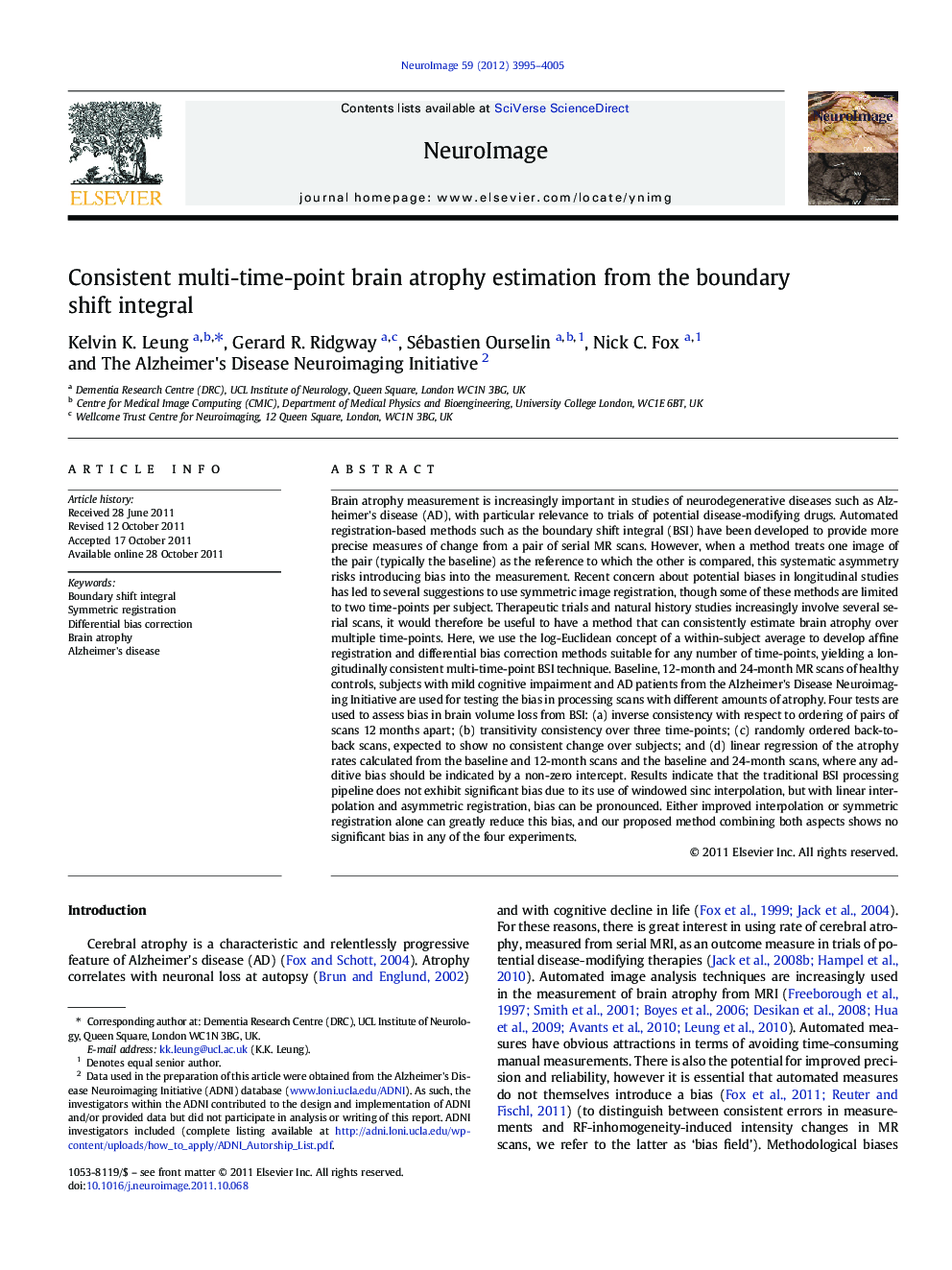| کد مقاله | کد نشریه | سال انتشار | مقاله انگلیسی | نسخه تمام متن |
|---|---|---|---|---|
| 6032891 | 1188742 | 2012 | 11 صفحه PDF | دانلود رایگان |
عنوان انگلیسی مقاله ISI
Consistent multi-time-point brain atrophy estimation from the boundary shift integral
دانلود مقاله + سفارش ترجمه
دانلود مقاله ISI انگلیسی
رایگان برای ایرانیان
کلمات کلیدی
موضوعات مرتبط
علوم زیستی و بیوفناوری
علم عصب شناسی
علوم اعصاب شناختی
پیش نمایش صفحه اول مقاله

چکیده انگلیسی
Brain atrophy measurement is increasingly important in studies of neurodegenerative diseases such as Alzheimer's disease (AD), with particular relevance to trials of potential disease-modifying drugs. Automated registration-based methods such as the boundary shift integral (BSI) have been developed to provide more precise measures of change from a pair of serial MR scans. However, when a method treats one image of the pair (typically the baseline) as the reference to which the other is compared, this systematic asymmetry risks introducing bias into the measurement. Recent concern about potential biases in longitudinal studies has led to several suggestions to use symmetric image registration, though some of these methods are limited to two time-points per subject. Therapeutic trials and natural history studies increasingly involve several serial scans, it would therefore be useful to have a method that can consistently estimate brain atrophy over multiple time-points. Here, we use the log-Euclidean concept of a within-subject average to develop affine registration and differential bias correction methods suitable for any number of time-points, yielding a longitudinally consistent multi-time-point BSI technique. Baseline, 12-month and 24-month MR scans of healthy controls, subjects with mild cognitive impairment and AD patients from the Alzheimer's Disease Neuroimaging Initiative are used for testing the bias in processing scans with different amounts of atrophy. Four tests are used to assess bias in brain volume loss from BSI: (a) inverse consistency with respect to ordering of pairs of scans 12Â months apart; (b) transitivity consistency over three time-points; (c) randomly ordered back-to-back scans, expected to show no consistent change over subjects; and (d) linear regression of the atrophy rates calculated from the baseline and 12-month scans and the baseline and 24-month scans, where any additive bias should be indicated by a non-zero intercept. Results indicate that the traditional BSI processing pipeline does not exhibit significant bias due to its use of windowed sinc interpolation, but with linear interpolation and asymmetric registration, bias can be pronounced. Either improved interpolation or symmetric registration alone can greatly reduce this bias, and our proposed method combining both aspects shows no significant bias in any of the four experiments.
ناشر
Database: Elsevier - ScienceDirect (ساینس دایرکت)
Journal: NeuroImage - Volume 59, Issue 4, 15 February 2012, Pages 3995-4005
Journal: NeuroImage - Volume 59, Issue 4, 15 February 2012, Pages 3995-4005
نویسندگان
Kelvin K. Leung, Gerard R. Ridgway, Sébastien Ourselin, Nick C. Fox, The Alzheimer's Disease Neuroimaging Initiative The Alzheimer's Disease Neuroimaging Initiative,